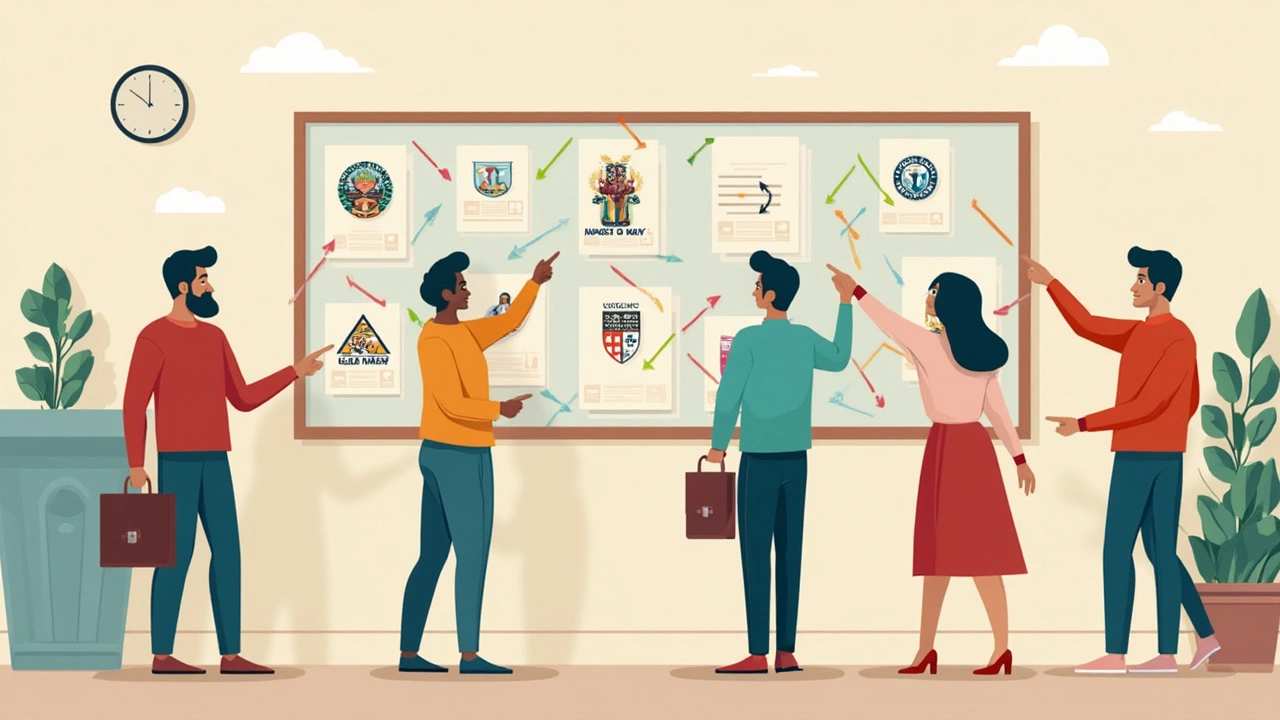Here's the question everyone asks the moment they start thinking about business school: how many MBA programs should you actually apply to? The truth is, there's no one-size-fits-all answer—some folks swear by three, others end up applying to ten. But if you ask admissions consultants and real applicants, you'll hear the same thing: it all comes down to your personal goals, risk tolerance, and how much work you're willing to put in.
Trying to game the odds by carpet-bombing ten or more schools sounds obvious—but trust me, it gets overwhelming fast. Each school wants essays, recommendations, maybe even a video. It's tempting to think more applications mean better chances, but that's not always true if quality suffers. On the flip side, only applying to your dream schools makes sense if you’ve got a sky-high GMAT and gold-plated resume, but most of us need a mix.
If you’re a strong candidate for top schools, three to five apps can get you where you want. Feeling less sure or applying with a quirky background? You might look at five to eight. The sweet spot for most people lands around four to six—enough to cover your bases, not so many that your brain melts.
- Why the Application Number Matters
- Finding Your Target Zone
- Building a Balanced School List
- Common Mistakes (And How to Dodge Them)
- Tips for Efficient Application Management
- Stories from Recent Applicants
Why the Application Number Matters
Picking how many MBA programs to apply to isn’t just some number you pull out of thin air—it’s a pretty strategic move. The number of applications you send out can directly affect your stress levels, your shot at getting in, and even your future debt.
Let’s get real: MBA admissions are seriously competitive. From recent data, Harvard Business School had an acceptance rate under 10%, and Stanford was even stingier, accepting less than 7%. Most other top 20 schools hover around the 15-25% mark. Here’s a quick snapshot from last year:
| School | Acceptance Rate |
|---|---|
| Stanford GSB | 6.9% |
| Harvard Business School | 9.5% |
| Wharton | 14.4% |
| INSEAD | 32.0% |
Applying to just one or two super-selective schools is risky unless you’re a total standout. But applying to too many can stretch your time, focus, and budget. Remember, each application costs money—usually between $200 and $275—not to mention test score reports, travel for interviews, and hours of essay writing. Burnout hits fast if you go overboard.
There’s also another angle: your chances actually improve when you target a wisely chosen range of schools. You get to mix "reach" schools (where the odds are slim), "target" schools (where you match the class profile), and "safety" schools (where you’re above the typical admit). This variety gives you some breathing room. It’s also worth thinking about financial aid—more admits can mean better scholarship options, and schools sometimes compete for strong candidates.
Bottom line? The number isn’t just a digit. It helps you control your odds, keep sane during admissions season, and maybe even save some cash.
Finding Your Target Zone
The sweet spot for MBA applications really depends on your profile and how risky you want to play it. Instead of picking a random number, the smart move is to think strategically about which schools fit you best and what your actual chances look like. The stats from the Graduate Management Admission Council show that the average applicant sends out applications to about five schools. But the real magic is in how you pick those five.
Here's what the process looks like for most people:
- Figure out your GMAT or GRE score and how it stacks up with admitted students at your dream schools.
- Be honest about your work experience, GPA, and extracurriculars.
- Think about school culture, location, program strengths, and post-MBA goals—don't waste time on schools that don't fit your ambitions.
To break it down, admissions experts usually tell applicants to divide their list into three buckets:
- Reach schools: Ultra-competitive, where your stats are below average, but you want to take the shot.
- Target schools: Places where your numbers are right in the middle of the pack—good odds if you craft a solid story.
- Safe schools: You match or beat the typical stats—they should be your backup plans, not afterthoughts.
"Don’t just chase the brand—choose places where you'd actually be happy and can grow. The right school for someone else may not be right for you," says Linda Abraham, founder of Accepted.com.
Check this quick table to see how the buckets usually break out for a balanced approach:
| School Type | # of Schools | Example |
|---|---|---|
| Reach | 1-2 | Stanford GSB, Harvard |
| Target | 2-3 | Ross (Michigan), Duke Fuqua |
| Safe | 1-2 | SMU Cox, Indiana Kelley |
Don’t forget, the number of applications should also fit your life and your energy. Every new app means more essays, more deadlines, and more headaches chasing recommendations. A polished application beats a rushed one, every time. So, find your target zone, stick to it, and don't let FOMO push you past what you can handle.
Building a Balanced School List
Your MBA application strategy needs a balanced list—one that covers a range of MBA programs instead of gambling it all on a single option. The trick is mixing “reach,” “target,” and “safety” schools, just like you probably did for undergrad. Each category is different based on stats, but the main idea is to give yourself real options come decision time, not just wishful thinking.
Here's a breakdown of what each type of school usually means:
- Reach schools: Places where your GMAT, GPA, or experiences are below the average admitted student. These are big names—think Stanford GSB or Harvard—where even perfect stats don't guarantee admission.
- Target schools: Where your profile fits right in the middle range of their admitted class. Not a shoo-in, but you have a solid shot if you bring your best.
- Safety schools: Programs where your stats are well above average, so you’re likely to get admitted if everything else lines up.
A good rule? Aim for 1-2 schools in each bucket. For most, that means 5-6 schools total. That keeps things manageable and lets you go all-in on quality for each application.
Not sure where you land? Check out average GMAT scores and class profiles on the MBA websites. Here’s a quick sample of recent stats from well-known programs (2024 incoming class):
| School | Average GMAT | Average GPA | Acceptance Rate |
|---|---|---|---|
| Stanford GSB | 738 | 3.8 | 6% |
| Wharton | 728 | 3.6 | 14% |
| Kellogg | 727 | 3.7 | 20% |
| Indiana Kelley | 668 | 3.3 | 37% |
But stats aren’t the only thing. Consider geography, program style (full-time, part-time, online), culture, and your career dreams. Talk to current students—some schools even track how much you engage. And don’t forget: schools care about your fit with them as much as you care about their brand.
If you want to keep things organized, use a spreadsheet. Track deadlines, requirements, your fit for each program, and which essays you’ve tackled. Staying on top of details will help you avoid last-minute stress and make sure each application is your best.
Having a MBA application game plan with a well-mixed list doesn’t make you less ambitious—it just makes you more likely to land somewhere that appreciates your strengths.

Common Mistakes (And How to Dodge Them)
People trip up on MBA applications all the time—and usually, it’s not about being a bad fit for business school. Most folks just run into the same avoidable pitfalls again and again. Want to know how to avoid the headaches? Here’s what to watch for:
- Going All-In on Super-Reach Schools: Some applicants only pick the most famous names, thinking, "If I get into one, I’m golden." But top programs like Stanford GSB and Harvard Business School admit less than 10% of applicants, even when you have great stats. If your list is all reach, you could end up with zero admits. The fix: add a blend of dream, solid, and safety MBA programs.
- Sloppy, Rushed Applications: Spreading yourself too thin means essays sound generic, recommendations feel disconnected, and your story gets lost. If you can’t give every app proper attention, your odds drop fast. It's way better to send out fewer, well-crafted applications.
- Ignoring School Culture: A lot of people use the same resume and essays everywhere, but every MBA program has its own vibe. Wharton values teamwork and analytics, Kellogg loves collaboration, and MIT’s Sloan wants evidence of action. If you don’t research and customize for each school, admissions teams spot it right away.
- Missing Deadlines: This one still happens all the time! Some MBA programs run on rolling admissions, which means the later you apply, the harder it gets. Accidentally confusing round deadlines or missing one altogether is like shooting yourself in the foot—stay super organized and set calendar reminders.
- Overestimating Safety Schools: Safeties can surprise you. These programs know when applicants are treating them as backups, so don’t phone it in. If your desire to attend isn’t convincing, they might just say "no thanks." Put in work to show real interest, even for your backups.
If you want a practical tip: build a spreadsheet with schools, requirements, and deadlines. Keep notes on why you like each, any school visits, and how your background fits. Checking things off—like sending scores or confirming recommenders—will help you stay on track. And above all, don’t let pride or panic guide your strategy. A balanced, thoughtful approach is always stronger than a frantic or overconfident one.
Tips for Efficient Application Management
Staying organized is everything when you're juggling multiple MBA applications. The deadlines hit fast, essays start looking the same, and it’s easy to lose track of important details. Here are some practical ways to keep your process on track—and your sanity intact.
- Build yourself a tracker: Google Sheets or Excel can be life savers. Log every school, deadline, essay topic, recommendation requirements, and interview dates. Color-code by status so you know in one glance what’s done and what still needs attention.
- Set weekly mini-deadlines. Don’t wait until the last minute to write all those essays. Block off specific evenings or weekends for drafts, and check your progress every Sunday night. Small steps add up fast.
- Recycle strategically, but personalize. Sure, core story ideas can work across applications, but every MBA wants to see why you fit their unique culture. Always tweak your "Why this school?" answers. Worst case, you copy-paste the wrong school name—not a great look.
- Ask for recommendations early. Professors and bosses get swamped, too. Give them at least a month, and supply a summary of your goals and why you’re applying. You’ll make their life easier and get stronger letters.
- Join an online community. Reddit’s r/MBAdmit, GMAT Club, or even dedicated Discord groups offer advice, essay reviews, and reminders about hidden deadlines.
- Back everything up. Cloud drives are your friend. Essays, application answers, and even your tracker—keep copies in Google Drive or Dropbox in case your laptop has a meltdown mid-essay.
- Take breaks. Honestly, this process is a marathon, not a sprint. A walk or a binge-watch break can actually help you come back with fresh edits and clearer eyes.
Your future classmates are dealing with the same stress. Find ways to connect, swap tips, and lean on each other—sometimes the best advice isn’t in a book, but from someone who just hit “submit” last night.
Stories from Recent Applicants
I talked to a bunch of folks who just wrapped up their MBA admissions, and they each had a different take on the "how many schools" debate. Their experiences aren’t just random stories—they show real-world outcomes and offer some surprising lessons.
First up, Jamie, a fintech manager from Austin, decided three schools were enough. She aimed high: Harvard, Stanford, and Wharton. She spent about 60 hours on her essays, tailored her pitch to each school, and nailed the interviews. She got into Wharton. Jamie said, “Focusing on just three let me keep my energy up and make every part of every application shine.” Still, she admits the nerves were real—she knew if she struck out, that was it for the year.
Then there’s Raj from Chicago, who took the opposite route: he sent out nine apps, ranging from Booth and Kellogg to Indiana University and Rice. By application five, he felt burnt out and admitted the last couple weren’t his best work. In the end, he landed interviews at four schools and got an offer from Kellogg. Raj now thinks his sweet spot would’ve been five, max. “After the fifth app, I felt like I was repeating myself. It’s easy to lose steam,” he told me.
Sophia, a non-traditional candidate from New York—a teacher pivoting to business—went with six. She split between competitive programs and some that were a bit more realistic. She ended up with two admits, including one dream program in Boston. Sophia stressed that she spent nearly as much time researching schools as she did writing essays. “Don’t just look at rankings. Go deeper: the teaching style, clubs, scholarship options. It pays off.”
| Name | Background | # of Schools | Interviews | Admits | Main Takeaway |
|---|---|---|---|---|---|
| Jamie | Fintech | 3 | 3 | 1 | Focus means better quality per app |
| Raj | Consulting | 9 | 4 | 1 | Too many = burnout, less quality over time |
| Sophia | Education | 6 | 4 | 2 | Balanced list gives a safety net |
If you notice a trend, it’s this: more doesn’t always mean better. Raj’s story echoes what a 2023 Poets&Quants survey found—the average number of MBA apps per American applicant is between four and six, and those who go past that usually see diminishing returns. It’s not just about increasing your odds, but making sure you actually want to attend every school you apply to. Taking time to build a thoughtful, targeted list puts you way ahead of the game.
So when considering that big decision about your MBA applications, remember you’ll get the best results from a focused strategy, not just a big stack of apps. Leaning into real research and self-awareness can save you time and some serious stress.





